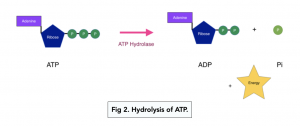ATP as an Energy Source (A-level Biology)
ATP as an Energy Source
Hydrolysing ATP
ATP is an Immediate Energy Source
- The body cannot directly get its energy from glucose. Glucose is not a direct energy source. Instead, the body uses the energy released from breaking down glucose, to drive phosphorylation of ADP. This makes ATP, which is an immediate energy source that cells can use quickly.
- Energy is stored in the bonds joining phosphate groups. The energy in ATP molecules is stored within the phosphoanhydride bonds (high energy between the three phosphate groups. In order to release this energy, the bond must be broken. This happens through hydrolysis, which we will recap here.
- The phosphate bonds are broken by hydrolysis. Hydrolysis of ATP forms ADP (adenosine diphosphate) and an inorganic phosphate group (Pi). This hydrolysis is catalysed by the enzyme ATP hydrolase. ATP hydrolase can further catalyse ADP into adenosine monophosphate (AMP) and a second inorganic phosphate group.

ATP, or adenosine triphosphate, is a molecule that serves as the main source of energy for cellular processes in living organisms. It acts as a currency for energy transactions within cells.
ATP stores energy in the bonds between its phosphate groups. When the bond between the second and third phosphate groups is broken, energy is released and can be used by cells for various processes.
ATP is used as an energy source for a variety of cellular processes, including muscle contraction, ion transport across membranes, and the synthesis of proteins and lipids. It is also used for energy-intensive processes such as cell division and growth.
ATP is produced in cells through cellular respiration and photosynthesis. Cellular respiration is a process that takes place in the mitochondria of eukaryotic cells and generates ATP through the breakdown of glucose. Photosynthesis, which takes place in the chloroplasts of plants, generates ATP through the capture of light energy.
Cellular respiration is the process that generates ATP in cells. This process takes place in the mitochondria and involves the breakdown of glucose to release energy. The energy is then used to produce ATP.
The breakdown of ATP releases energy by breaking the bond between the second and third phosphate groups. This reaction releases energy that can be used by cells for various processes.
The production of ATP plays a critical role in the energy balance of cells. By producing ATP, cells can maintain their energy levels and carry out their vital processes. If the production of ATP decreases, cells can become energy-deficient and may stop functioning properly.
ATP is considered the universal energy source for cells because it can be produced by all living organisms and is used by all cells for energy transactions. This makes ATP a critical component of cellular metabolism and essential for the survival of living organisms.
The study of ATP is important for future careers in Biology because it provides a fundamental understanding of cellular energy metabolism. This knowledge is essential for careers in areas such as biochemistry, physiology, and medicine, where an understanding of cellular energy metabolism is crucial.
The study of ATP is approached in A-level Biology through a combination of theoretical and practical work. Students learn about the structure and function of ATP, the stages of cellular respiration, and the role of ATP in cellular processes. They also conduct practical experiments to demonstrate cellular respiration and the production of ATP, gaining hands-on experience in cellular energy metabolism.






Still got a question? Leave a comment
Leave a comment